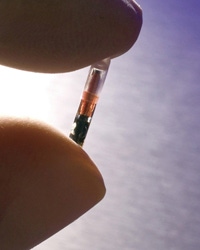Implantable RFID Chip Helps to ID Medical Devices
March 15, 2012

The implantation of a medical device in the body is often just the beginning of the story. Once a device is firmly implanted, the ability to trace and identify it can often be as important as the implant itself. Responding to this need, VeriTeQ Acquisition Corp. is offering an FDA-cleared radio-frequency identification (RFID) microchip for the purpose of identifying implanted medical devices.
"After a device containing our VeriChip RFID microchip is implanted in the body, an external scanner can read the ID number on the chip to gain access to all sorts of information stored in a database, including who manufactured the implant, how long it has been in the body, and which doctor implanted it," remarks Scott Silverman, CEO of VeriTeQ. "Even personal health records can be linked to the chip if the patient requests it." Originally designed to identify high-risk patients and their medical records in an emergency or other clinical situation, the VeriChip RFID chip is finding increasing use as a technology for identifying such medical devices as vascular ports and breast implants.
Measuring 8 ´ 1 mm--about the size of a grain of rice--the ASIC microchip is a fairly simple product that consists of an RF coil and a glass-like casing material. As a stand-alone medical device, it can be inserted into a cannula for subcutaneous injection into the body. But as a medical device component, it can be inserted into an implant during the manufacturing process.
For example, in vascular-port applications, the chip can be used to properly identify the vascular port in a patient in order to help ensure the appropriate delivery of chemotherapy drugs to the body, Silverman explains. In such cases, the port, which contains the microchip, is inserted into the body and then scanned when a patient arrives for treatment. "The chip identifies the serial number on the port and what type of port it is. In this application, our technology helps ensure patient safety by identifying the correct medication dosage," he says.
Following the recent international scare involving breast implants from a French company that used industrial silicone to decrease costs, the European Union began to consider requiring manufacturers to embed microchips in such devices to provide accurate and immediate traceability. "The breast implant scare opened up a Pandora's Box of concerns about the potential need to recall faulty breast implants," Silverman says. "The EU Commission asked: How do you identify breast implants once they're inside the body, especially if patients have moved, if they now have different physicians, or if they don't have access to the relevant manufacturer or physician databases?
Although the chip will soon be marketed for use in high-speed vascular ports, its use in breast implants should not be far behind, Silverman notes. "We hope that talks with breast implant manufacturers will evolve quickly. And since the chip has already received FDA clearance for use inside the body, we're hoping to commercialize it for breast implant applications sometime in 2012."
VeriTeQ Acquisition Corp.
Delray Beach, FL
About the Author(s)
You May Also Like

